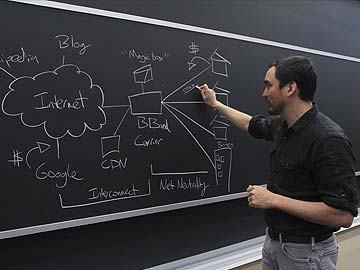

THE ATTENTION MERCHANTS, by Tim Wu (2016, Knopf Publishers)
This book is an answer to many questions, including a naming of “who’s who” in technology over the past twenty years, and at the same time brings to the proverbial table a variety of perceptions about technology and the media and its propensity to invite great trust on the one hand and / or great alienation on the other. Jean – Philippe Desbordes, in 2007, along the same lines in 2007, had published in France a monograph along the same lines with the premise that the medias alienated and distorted the life’s experience of those audiences to its various forms, especially children and trusting parties (the book was entitled MON ENFANT N’EST PAS UN COEUR DE CIBLE; Wu himself cites other texts such as Upton Sinclair’s The Jungle, The Man Nobody Knows (1923,) by Bruce Barton, The Hidden Persuaders (McDonald, 1957), and still others such as Life after Television (G. Gilder, 2007)). The overall premise of the book is by its nature the modern media is so complex and influential in its presentation, again especially to and fundamentally in governing the lives of the young that it cannot be trusted, even for basic presentation in its various forms, again especially concerning the visual and video / film arts.
The message of the Wu text is somewhat more tepid, though again basically along the same lines as the Desbordes idea – the media cannot be trusted, probably starting with its inception with the inclusion of some hard copy advertisements in the newspapers in New York in the late 1800’s. Wu nonetheless portrays those behind “harvesting” – a way of capturing and using human attention – as constructive in many ways and created and continued by many well – meaning and ambitious, constructive – minded people. This begins again with the including of newspaper ads, a great innovation, by the “New York Sun” as founded by Benjamin Day in the late 19th century. The idea of harvesting was originated apparently by Claude C. Hopkins, again in New York, as a way to capture and use human attention but with the most Catholic (and Methodist) of reasons and practices : As a way of taking constructive advantage and use of basic literacy and literary awareness and with Godly thoughts; in fact a sort of praying to the image and impressions of things if one will. Though the invention of technical approaches to advertising dates back a while, so does the use of these techniques in the confidence game of which Clark Stanley and the late 1800’s fads for different types of snake oils and related liniments. Claude Hopkins joined in the frenzy of the day led by Stanley for mail order liniments based on snake oils (as formally introduced and very successfully at the 1893 New York World’s Fair); whereas many of these medicines as same were called, turned out to be ordinary poison.
The media history that Timothy Wu weaves in this book has more to do with his research and findings into various historical media figures, even from as improbable professional areas as they were – the military of U.K. Lord Kitchener, the WWI propaganda machine of Woodrow Wilson, the original societal role and influence of Freudian psychology, and the various human personalities behind these different influences and levels of analysis : George Creel, again Claude Hopkins, Walter Lippmann of the ‘New Republic’, Theodore McManus, and still many others in the beginning and these masters of the “harvest” or power of suggestion succeeded by more and more sophisticated methods and media people including even B.F. Skinner; T. Leary and M. Mcluhan, Richard Alpert, etc.; Jonathan Robbin and Steven Case, all the way up to the media pioneers of today. Not the actors, but the producers and business people of the content that includes the bevy of actors to whom another set of media – influenced individuals aspires. The text at hand also condemns the extreme cases of plain and simple demagogues such as William Jennings Bryan, and even more extreme in the situation of Hitler and the Republic of German under the Nazis.
The former subject matter and more, all greatly documented with annotations and stories, anecdotes and narrative vignettes that are completely worthwhile traversing into the present world of the media, legacy of modern computing models that included Prodigy / AOL, Commodore, Magnavox, Zenith, and their leading personalities that included people Wu calls “the invaders” of the States. It is not improbable, nor outside the world of suggestion and psychological influence these businesses, essentially, and their leading personalities again lead to Apple, Facebook and Google. Microsoft also plays a role of a terrific software company, complex and with its own win, lose or draw – type computing / media model of which the Windows – based media, Microsoft NBC, and with its own sensations and celebrities. Also, whereas the original suggestion – based adverts had been formalized and very thoroughly worked – out photocopy in newspapers and magazines, and still is; the media today depends much more on the mouse – clicks of the internet, “going viral”, blogging and various feeds including video feeds, streaming and the like; and this all with neurasthenic homeostasis of Twitter, YouTube, and Facebook / Instagram in a dominant social media sector where to be different is greatly to be better – and much of this appear to be dominated by Apple Computer, uber alles, due to the multi – faceted and multi – functionality of its OS, probably. Wu encourages everyone within the scope of the media, the internet, and his analysis of these and more : Hardware, operating systems, software and applications, and the various personalities behind these, to continue creating and dreaming of the future possibilities for communications and the human reclamation of technology despite the obvious productivity gains of personal computing and the bargain in the utility and / or utilities of the same. This theme that runs through the entire book has one in the technology, entertainment, design paradigm and in the actual computing is that regardless of one’s scale (e.g., database all the way up through data cloud) that one’s technology environment should feature everything from healthy skepticism to outright denial and mistrust according to its various elements as presented, and with specific respect to media content, past, present and future.
Advertisements Share this:




